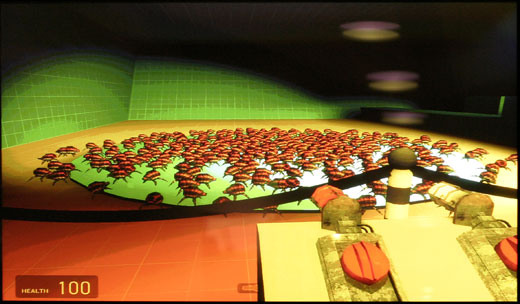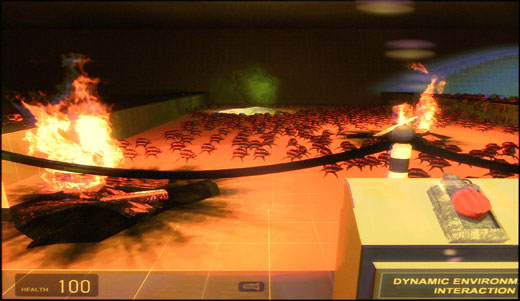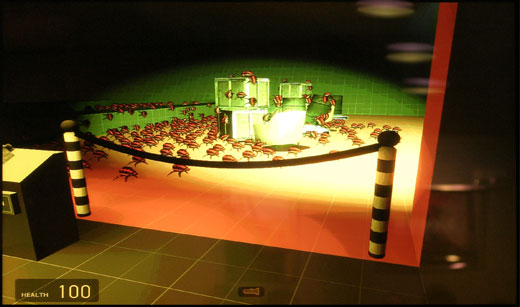Valve Hardware Day 2006 - Multithreaded Edition
by Jarred Walton on November 7, 2006 6:00 AM EST- Posted in
- Trade Shows
Gaming's Future, Continued
So what can be done besides making a world look better? One of the big buzzwords in the gaming industry right now is physics. Practically every new game title seems to be touting amazing new physics effects. Perhaps modern physics are more accurate, but having moderate amounts of physics in a gaming engine is nothing new. Games over a decade ago allowed you to do such things as pick up a stone and throw it (Ultima Underworld), or shoot a bow and have the arrow drop with distance. Even if the calculations were crude, that would still count as having "physics" in a game. Of course, there's a big difference in the amount of physics present in Half-Life and those present in Half-Life 2, and most people would agree that the Half-Life 2 was a better experience due to the improved interaction with the environment.
Going forward, physics can only become more important. One of the holy grails of gaming is still the creation of a world that has a fully destructible environment. Why do you need to find a stupid key to get through a wooden door when you're carrying a rocket launcher? Why can't you blow up the side of the building and watch the entire structure fall to the ground, perhaps taking out any enemies that were inside? How about the magical fence that's four inches too tall to jump over - why not just break it down instead of going around? It's true that various games have made attempts in this direction, but it's still safe to say that no one has yet created a gaming environment that allows you to demolish everything as you could in the real world (within reason). Gameplay still needs to play a role in what is allowed, but the more the possibilities for what can be done are increased, the more likely we are to see revolutionary gameplay.
Going along with physics and game world interactions, Valve spoke about the optimizations they've made in a structure called the spatial partition. The spatial partition is essentially a representation of the game world, and it is queried constantly to determine how objects interact. From what we could gather, it is used to allow rough approximations to take place where it makes sense, and it also helps determine where more complex (and accurate) mathematical calculations should be performed. One of the problems traditionally associated with multithreaded programming has been locking access to certain data structures in order to keep the world in a consistent state. For the spatial partition, the vast majority of the accesses are read operations that can occur concurrently, and Valve was able to use lock-free and wait-free algorithms in order to greatly improve performance. A read/write log is used to make sure the return values are correct, and Valve emphasized that the lock-free algorithms were a huge design win when it came to multithreading.
Another big area that can stand to see a lot of improvement is artificial intelligence. Often times, AI has a tacked on feel in current games. You want your adversaries to behave somewhat realistically, but you don't want the game to spend so much computational power figuring out what they should do that everything crawls to a slow. It's one thing to wait a few seconds (or more) for your opponent to make a move in a chess match; it's a completely different story in an action game being rendered at 60 frames per second. Valve discussed the possibilities for having a greater number of simplistic AI routines running, along with a few more sophisticated AI routines (i.e. Alyx in Episode One).



They had some demonstrations of swarms of creatures interacting more realistically with the environment, doing things like avoiding dangerous areas, toppling furniture, swarming opponents, etc. (The action was more impressive than the above screenshots might indicate.) The number of creatures could also be increased depending on CPU power (number of cores as well as clock speed), so where a Core 2 Quad might be able to handle 500 creatures, a single core Pentium 4 could start to choke on only 80 or so creatures.
In the past, getting other creatures in the game world to behave even remotely realistically was sufficient -- "Look, he got behind a rock to get shelter!" -- but there's so much more that can be done. With more computational power available to solve AI problems, we can only hope that more companies will decide to spend the time on improving their AI routines. Certainly, without having spare processor cycles, it is difficult to imagine any action games spending as much time on artificial intelligence as they spend on graphics.
There are a few less important types of AI that could be added as well. One of these is called "Out of Band AI" -- these are AI routines that are independent of the core AI. An example that was given would be a Half-Life 2 scene where Dr. Kleiner is playing chess. They could actually have a chess algorithm running in the background using spare CPU cycles. Useful? Perhaps not that example, unless you're really into chess, but these are all tools to create a more immersive game world, and there is almost certainly someone out there that can come up with more interesting applications of such concepts.
So what can be done besides making a world look better? One of the big buzzwords in the gaming industry right now is physics. Practically every new game title seems to be touting amazing new physics effects. Perhaps modern physics are more accurate, but having moderate amounts of physics in a gaming engine is nothing new. Games over a decade ago allowed you to do such things as pick up a stone and throw it (Ultima Underworld), or shoot a bow and have the arrow drop with distance. Even if the calculations were crude, that would still count as having "physics" in a game. Of course, there's a big difference in the amount of physics present in Half-Life and those present in Half-Life 2, and most people would agree that the Half-Life 2 was a better experience due to the improved interaction with the environment.
Going forward, physics can only become more important. One of the holy grails of gaming is still the creation of a world that has a fully destructible environment. Why do you need to find a stupid key to get through a wooden door when you're carrying a rocket launcher? Why can't you blow up the side of the building and watch the entire structure fall to the ground, perhaps taking out any enemies that were inside? How about the magical fence that's four inches too tall to jump over - why not just break it down instead of going around? It's true that various games have made attempts in this direction, but it's still safe to say that no one has yet created a gaming environment that allows you to demolish everything as you could in the real world (within reason). Gameplay still needs to play a role in what is allowed, but the more the possibilities for what can be done are increased, the more likely we are to see revolutionary gameplay.
Going along with physics and game world interactions, Valve spoke about the optimizations they've made in a structure called the spatial partition. The spatial partition is essentially a representation of the game world, and it is queried constantly to determine how objects interact. From what we could gather, it is used to allow rough approximations to take place where it makes sense, and it also helps determine where more complex (and accurate) mathematical calculations should be performed. One of the problems traditionally associated with multithreaded programming has been locking access to certain data structures in order to keep the world in a consistent state. For the spatial partition, the vast majority of the accesses are read operations that can occur concurrently, and Valve was able to use lock-free and wait-free algorithms in order to greatly improve performance. A read/write log is used to make sure the return values are correct, and Valve emphasized that the lock-free algorithms were a huge design win when it came to multithreading.
Another big area that can stand to see a lot of improvement is artificial intelligence. Often times, AI has a tacked on feel in current games. You want your adversaries to behave somewhat realistically, but you don't want the game to spend so much computational power figuring out what they should do that everything crawls to a slow. It's one thing to wait a few seconds (or more) for your opponent to make a move in a chess match; it's a completely different story in an action game being rendered at 60 frames per second. Valve discussed the possibilities for having a greater number of simplistic AI routines running, along with a few more sophisticated AI routines (i.e. Alyx in Episode One).



They had some demonstrations of swarms of creatures interacting more realistically with the environment, doing things like avoiding dangerous areas, toppling furniture, swarming opponents, etc. (The action was more impressive than the above screenshots might indicate.) The number of creatures could also be increased depending on CPU power (number of cores as well as clock speed), so where a Core 2 Quad might be able to handle 500 creatures, a single core Pentium 4 could start to choke on only 80 or so creatures.
In the past, getting other creatures in the game world to behave even remotely realistically was sufficient -- "Look, he got behind a rock to get shelter!" -- but there's so much more that can be done. With more computational power available to solve AI problems, we can only hope that more companies will decide to spend the time on improving their AI routines. Certainly, without having spare processor cycles, it is difficult to imagine any action games spending as much time on artificial intelligence as they spend on graphics.
There are a few less important types of AI that could be added as well. One of these is called "Out of Band AI" -- these are AI routines that are independent of the core AI. An example that was given would be a Half-Life 2 scene where Dr. Kleiner is playing chess. They could actually have a chess algorithm running in the background using spare CPU cycles. Useful? Perhaps not that example, unless you're really into chess, but these are all tools to create a more immersive game world, and there is almost certainly someone out there that can come up with more interesting applications of such concepts.










55 Comments
View All Comments
primer - Tuesday, November 7, 2006 - link
it's a nice article. i'm anxious to see what develops out of Valve in the near future.how about using some Athlon FX, Opteron 100/1200 series or higher speed Athlon X2s for crying out loud. i know that here is a performance gap even with the higher AMD models currently, but please show us an attempt at not being as one-sided.
jm20 - Tuesday, November 7, 2006 - link
The tests at 2.0 and 2.4 Ghz for the AMD chips are there, you can plot how it 'should' improve. Here are my scaling projections based on the data given for the 939 platform.AMD Speed single dual
2.0 14.0 27.0
2.2 15.5 29.5
2.4 17.0 32.0
2.6 18.8 35.0
2.8 20.8 38.2
3.0 23.1 41.7
I just hope this will show up correctly :/
Very interesting article, I'm very excited to see an almost linear improvement from single to dual core.
yacoub - Tuesday, November 7, 2006 - link
Your Tested Systems details on page 8 - the last three show a CPU of a Venice 3200+ oc'd to 2.4GHz (hey that's what I run too!), but the headings suggest they should really show Intel chips. :)yacoub - Tuesday, November 7, 2006 - link
Yes please make it only visual and not actually a part of the game, because much like trying too hard to make graphics look realistic, it really just adds more frustration for the player than anything else. It's already annoying in HL2 getting caught up on the edge of prop_physics related objects. The last thing we need is also getting caught or bumped by another player ;)
JarredWalton - Tuesday, November 7, 2006 - link
If the world is more interactive, there might not actually be a need for "prop physics" objects. There's also the potential to make a game with different gameplay mechanics depending on how the character interacts with the world. It sounds like initially Valve will make it a visual enhancement, to make entities look more lifelike in their behavior, but down the road others could potentially do more. Like most of the enhancements, what we want to see is how they can actually change and improve gameplay beyond just being visual.yacoub - Tuesday, November 7, 2006 - link
"You're doing a disservice to the customer if you're not using all of the CPU power."okay so that alone shows the need for dual-core so the customer can offload background tasks to a second core so the game can truly get 100% of a core. ;)
timmiser - Tuesday, November 7, 2006 - link
Background tasks?? I agree with Gabe that I want all of my CPU working the game. I'm sitting here with an Athlon X2 4800+ and I can't run Flight Sim X at an acceptable frame rate all the while I watch the graph that shows CPU#2 at idle while CPU#1 tries to run the entire program by itself!On another note, how about Microsoft develope some type of new API (DirecThread?) that automatically takes care of utilizing multiple cores so that game companies like Valve don't have to employ entire multi-threaded R&D divisions just so their games use both cores.
It seems like we are going back to the caveman days before DirectInput, DirectSound, & DirectX etc. Remember when you had to choose your sound card, joystick, and video card from a list within the game?? Let's not go there again!!
-Tim
JarredWalton - Tuesday, November 7, 2006 - link
That was a direct quote from... Gabe I think. Others might disagree, but I thought it was an interesting take on things. As for background tasks, they usually only need a bit of CPU time (less than 5% in most cases), so unless you really want to encode videos and play games at the same time....yacoub - Tuesday, November 7, 2006 - link
What a worthless attempt at sarcasm:Why not just say something normal like:
It's not omg-witty, but at least that sentence doesn't end with a preposition. @___@
JarredWalton - Tuesday, November 7, 2006 - link
Which obviously ruined the whole article. Seriously yacoub, a little tact with posting would be nice. Rather than stating:You could have just said something normal like:
We are real people, and derogatory adjectives like "worthless" tend to irritate more than help. You may not intend it that way, but imagine for a second someone talking about what you worked on for a couple days last week and describing it as "absolute garbage". The key word in "constructive criticism" is to actually make it constructive.
Now, thanks for the suggestion, and I'm more than happy to change things a bit to appeas people. Like most people, I just appreciate a bit more consideration, even if I'm just doing my job here. :) As the old cliche goes, you can catch more flies with honey than with vinegar. (Well, my grandpa used to say that anyway.)